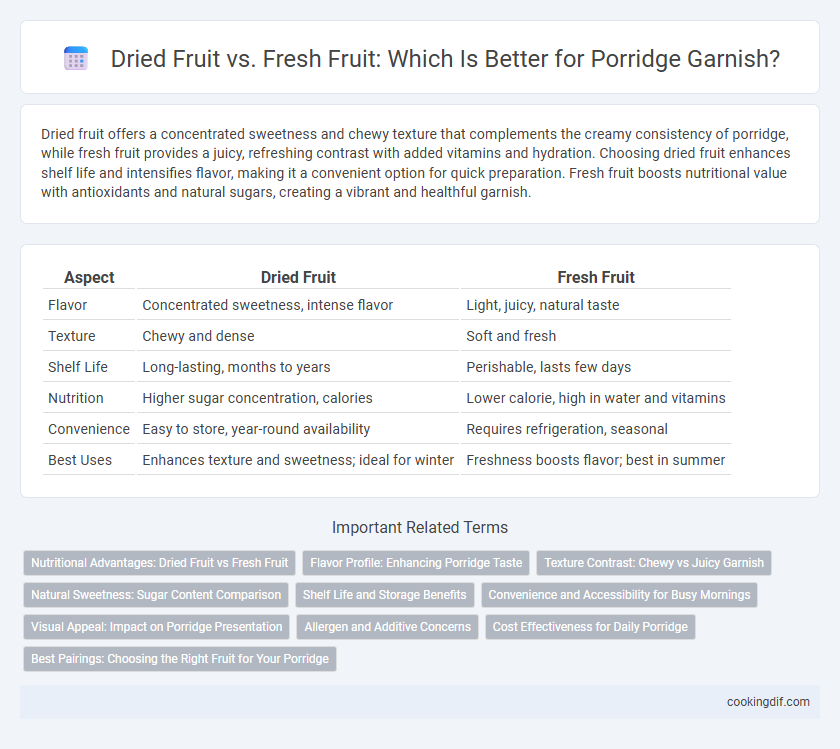Dried fruit offers a concentrated sweetness and chewy texture that complements the creamy consistency of porridge, while fresh fruit provides a juicy, refreshing contrast with added vitamins and hydration. Choosing dried fruit enhances shelf life and intensifies flavor, making it a convenient option for quick preparation. Fresh fruit boosts nutritional value with antioxidants and natural sugars, creating a vibrant and healthful garnish.
Table of Comparison
| Aspect | Dried Fruit | Fresh Fruit |
|---|---|---|
| Flavor | Concentrated sweetness, intense flavor | Light, juicy, natural taste |
| Texture | Chewy and dense | Soft and fresh |
| Shelf Life | Long-lasting, months to years | Perishable, lasts few days |
| Nutrition | Higher sugar concentration, calories | Lower calorie, high in water and vitamins |
| Convenience | Easy to store, year-round availability | Requires refrigeration, seasonal |
| Best Uses | Enhances texture and sweetness; ideal for winter | Freshness boosts flavor; best in summer |
Nutritional Advantages: Dried Fruit vs Fresh Fruit
Dried fruit offers a concentrated source of vitamins, minerals, and antioxidants, delivering higher fiber and iron content per serving compared to fresh fruit, which is rich in water and lower in calories. Fresh fruit provides hydration and a higher vitamin C content, essential for immune function and skin health, which can diminish during the drying process. Choosing between dried and fresh fruit for porridge garnish depends on the desired nutrient profile, with dried fruit enhancing micronutrient density and fresh fruit supplying hydration and vitamin C benefits.
Flavor Profile: Enhancing Porridge Taste
Dried fruit offers a concentrated sweetness and chewy texture that intensifies the flavor profile of porridge, often providing caramelized and rich notes. Fresh fruit contributes vibrant, juicy freshness with natural acidity, balancing the creaminess and adding a bright contrast to the dish. Combining both can create a layered taste experience, merging the deep, intense flavors of dried fruit with the lively, refreshing qualities of fresh fruit.
Texture Contrast: Chewy vs Juicy Garnish
Dried fruit offers a chewy texture that contrasts well with the creamy smoothness of porridge, adding a satisfying bite and concentrated sweetness. Fresh fruit provides a juicy garnish that introduces a burst of moisture and natural freshness, balancing the warm, soft porridge base. Selecting between dried or fresh fruit depends on the desired texture contrast and flavor intensity in the porridge experience.
Natural Sweetness: Sugar Content Comparison
Dried fruit contains a higher concentration of natural sugars compared to fresh fruit, offering a more intense sweetness that can significantly enhance the flavor of porridge with less quantity. Fresh fruit has a lower sugar content and provides a more subtle sweetness along with additional hydration, contributing to a lighter, fresher taste profile. Choosing between dried and fresh fruit for porridge garnish depends on desired sweetness levels and texture preferences, with dried fruit delivering concentrated sugar and fresh fruit offering natural moisture.
Shelf Life and Storage Benefits
Dried fruit offers a significantly longer shelf life than fresh fruit, making it ideal for extended storage without refrigeration and reducing spoilage in porridge garnish. Fresh fruit provides superior nutritional value and vibrant flavor but requires immediate use and refrigeration to prevent decay within a few days. Choosing dried fruit enhances convenience and reduces waste, while fresh fruit adds natural moisture and freshness to porridge.
Convenience and Accessibility for Busy Mornings
Dried fruit offers unmatched convenience and longer shelf life, making it ideal for quick, hassle-free porridge garnishes during busy mornings. Fresh fruit, while providing superior flavor and nutritional value, requires preparation and faster consumption, which may not suit tight schedules. Opting for dried options like raisins or apricots ensures easy storage and instant use without compromising on taste.
Visual Appeal: Impact on Porridge Presentation
Dried fruit enhances porridge presentation with its vibrant, concentrated colors and chewy texture, creating a visually appealing contrast against the creamy base. Fresh fruit offers a bright, natural appearance with juiciness that adds freshness and an inviting look to the dish. Combining both dried and fresh fruit garnishes maximizes color variety and texture, elevating porridge's overall visual appeal and making it more enticing.
Allergen and Additive Concerns
Dried fruit used as a porridge garnish often contains added sulfites and preservatives that can trigger allergic reactions or sensitivities, making them less ideal for allergy-prone individuals. Fresh fruit, in contrast, offers a natural, additive-free option that minimizes exposure to potential allergens and artificial chemicals. Choosing fresh fruit reduces the risk of consuming unwanted additives while providing essential vitamins and fibers without allergenic concerns related to drying agents.
Cost Effectiveness for Daily Porridge
Dried fruit offers greater cost effectiveness for daily porridge garnishing due to its longer shelf life and lower price per serving compared to fresh fruit, which spoils quickly and requires frequent replacement. While fresh fruit provides superior taste and texture, the higher expense and potential waste make dried fruit a budget-friendly option for regular consumption. Incorporating dried fruit such as raisins, apricots, or dates maximizes value without sacrificing nutritional benefits in everyday porridge meals.
Best Pairings: Choosing the Right Fruit for Your Porridge
Dried fruit such as raisins, apricots, and dates provide concentrated sweetness and a chewy texture that pairs well with creamy porridge, while fresh fruit like berries, bananas, and apples add juiciness and vibrant flavor. The choice depends on the desired texture and sweetness level; dried fruits offer a longer shelf life and intense flavor bursts, whereas fresh fruits contribute freshness and nutritional benefits like vitamin C and antioxidants. Mixing both dried and fresh fruits can create a balanced flavor profile, enhancing taste complexity and nutritional value in your porridge.
Dried fruit vs Fresh fruit for porridge garnish Infographic

 cookingdif.com
cookingdif.com